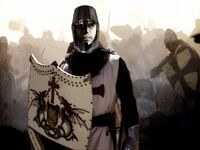Treason and Heresy[]
King Philip IV of France (1268-1315) already heavily in debt to the Knights Templar requested a further loan. The Knights Templar begrudgingly accepted this request, they were in his charge. On Friday the 13th, in October 1307, Jacques de Molay, the Grand Master of the Knights Templar, and 60 of his senior knights declared their independence from the king and country after the King of France declared them heretics and nullified all loans with the Templars.
Franco-Templar War[]
November 12, 1307 The Bitter Battle of Amiens. Battle hardened Knights defeated the French army in a

A Knights Templar fighting at Amiens
series of battles. February 5, 1308 The new year brought more difficulties for the independent Templar Kingdom. England claimed Amiens was ceded to them years ago, by the French king. In June 1309, A siege of the Templar lands was stopped before it started, through papal intervention. However, many battles continued for a year.
The French and Templars fought a devastating war throughout the French countryside. The Battle of Lyon was the deciding battle of the war when the French King Philip IV along with the Crown Prince Louis X led an army of 3000 French Knights, 5000 peasant warriors drawn from the surrounding countryside, 2000 men-at-arms, and 4000 Genoese crossbowmen descended upon the Knights Templar Army which consisted of 5000 Knights Templar and rebellious French Nobles and Knights, 3000 Swiss Pikemen, and 4000 Aragonese bowmen.
The Battle of Lyon began on 22 September, AD 1311 when a Templar scout reported the massive army coming

A dismounted Templar Knight pausing during the Battle of Lyon.
their way, this sparked a massive upheaval in the camp as the many men began to arm themselves for the coming battle. When the French arrived nearly three hours later they found the entire army of Templars ready for battle. The Aragonese and Genoese began the battle with a barrage of arrows and bolts shot across the land. The French knights, growing weary of waiting launched themselves and their peasants against the Templar army. The Knights Templar and their mercenaries and allies began the counter assault and they met in the middle of the battlefield. The fight turned into a slogging match as the superior trained Swiss and Templars soon began to route the ill-trained peasants. This left the French Knights and Men-at-Arms in peril of being overrun (as the Genoese had routed as soon as the Templars neared them); but they chose to stand and fight. After nearly two hours all the French Knights and Men-at-Arms were cut down by the Templars and Swiss along with the King of France.
The new King Philip V was forced to draw up a peace agreement with the Templars. The peace commission was headed by Pope Clement V. Over a year was spent on negotiating the terms of the treaty, meanwhile a tentative ceasefire was keeping France out of the fire for now. The Treaty of Avignon was signed on October 29, 1312 which gave the Pyrénées as the temporal land of the Knights Templar and France was forced to honour her former debts to the Templar, the final provision of the treaty stated that France and the Knights Templar may not go to war with each other for 100 years on the penalty of excommunication for whom-so-ever began the war.
Popes and Plagues[]
1315-1357 Bad weather and crop failures result in famines across Europe. Unsanitary conditions and malnutrition increase the death rate. Weather disasters increase crop infestation. Then a plague of smallpox hit Naples in the summer of 1317 and quickly spread through Europe.
A mixture of war, famine and plague ran rampant reducing the population by about 40%. After the death of Pope Clement V a young cardinal from Italy who took the name Romanus II was elected. During this time, neither king, pope nor peasant could escape the plague and Pope Romanus II fell to plague in October of 1319.
The papal seat entered into a state of Interregnum or Sede vacante , Latin for "the seat being vacant” and the leadership of the Catholic Church remained that way for many years. Changes were to come but it seemed to take forever. Fear, horror and death was known well by all, and many people feared the biblical apocalypse was upon them.
Prestor John[]
Prestor John was a Christian ruler of a small community of Christians residing within southern India, particularly the Saint Thomas Christians. The legendary ruler visited Jerusalem in 1320 and stayed there until 1326 when he returned to India.
While in Judea he found the idea of a military monastic order to protect Christians highly effective and when he returned to India he and 300 others founded the भारत में सेंट थॉमस की पवित्र मठ आदेश (Holy Monastic Order of Saint Thomas in India).
The Order of St Thomas built several monastery-forts around the Christian communities of India, this effectively stopped the Hindu and Muslims from attacking the Christians, the Christians in the area soon began to expand without the constant attacks by the outsiders and by the 1430's they had well over 10,000 people claiming to be Christians within the protected areas of Christian India.
